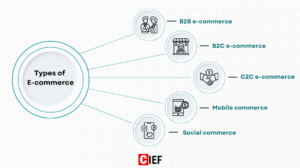As technology has advanced, so too has the way in which we conduct business. One of the most notable changes has been the growth of e-commerce. The growth of e-commerce can be attributed to several factors. Firstly, there has been a significant increase in internet usage around the world. In 2000, there were only 400 million internet users globally. By 2015, that number had grown to 3 billion. This growth has allowed businesses to more easily reach consumers online. Secondly, there has been a rise in digital purchasing habits among consumers. In 2016, global online retail sales reached $1.8 billion US dollars.
What is E-commerce?
E-commerce is a term used to describe the buying and selling of goods and services over the internet. It allows consumers to buy items from around the world, and businesses to sell their products to consumers all over the world. E-commerce can be done through a website or a phone app. To understand better about e-commerce, let’s talk about the different types of e-commerce.

B2B e-commerce
B2B e-commerce is a form of e-commerce that is used by businesses to conduct transactions with other businesses. This type of e-commerce typically involves the sale of goods or services, and it can be used to buy and sell products, services, and data. B2B e-commerce can help businesses save time and money by streamlining their processes and making it easier to find and purchase products and services.
B2C e-commerce
B2C e-commerce is a system where businesses can sell products and services to consumers over the internet. This type of e-commerce can be beneficial to both businesses and consumers because it allows businesses to reach a larger audience, and it allows consumers to find and purchase products and services more easily. Additionally, B2C e-commerce can help businesses reduce their costs by eliminating the need for a physical storefront.
C2C e-commerce
C2C e-commerce is a type of e-commerce where consumers sell products and services to other consumers. This type of e-commerce is often used for peer-to-peer transactions, such as selling used items on online marketplaces. C2C e-commerce can also be used for business-to-consumer transactions, such as when a company sells products or services to consumers through an online storefront.
Mobile commerce
Mobile commerce is the buying and selling of goods and services using a mobile device, such as a phone or tablet. It is growing rapidly because people are increasingly using their mobile devices to shop. One example of mobile commerce is when you use your phone to buy something from a store’s website. You can also use your phone to pay for things in person as you would with a credit card.
Social commerce
Social commerce is when people use social media to buy and sell things. It has become more popular in recent years as more and more people are using social media. For example, you might see a post on Facebook that someone is selling a dress, t-shirt, or electronic appliance, and you can click on the link to buy it.
Conclusion
There are many different types of e-commerce. It is important to understand the different types and their benefits in order to select the right type for your business. Be sure to research the options and consult with experts to make sure you are making the best decision for your company.













